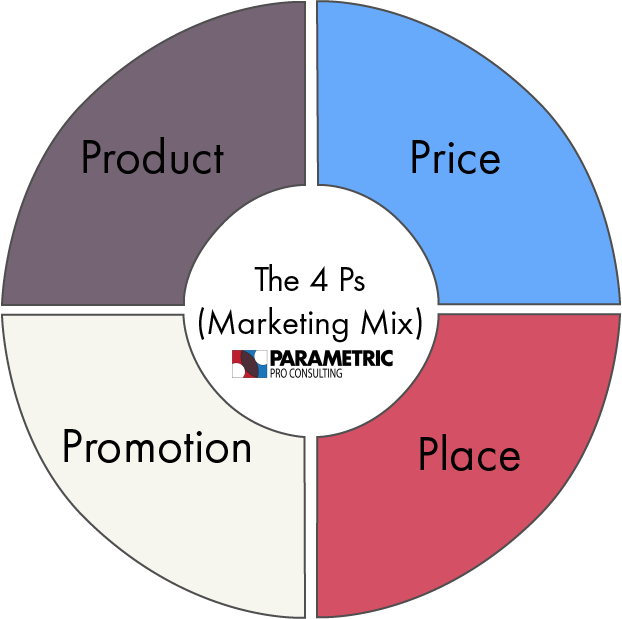What is the 4 Ps framework?
The 4 Ps is one of the most popular marketing frameworks that businesses use. Also known as the marketing mix, the framework identifies the four main elements that are most crucial to customer acquisition: Product, Price, Promotion, and Place (see Figure 1).

By understanding this framework, you will be able to develop effective marketing strategies that will fuel the growth of your business. Marketing campaigns can get complicated quickly, so this framework effectively uses Mutually Exclusive and Collectively Exhaustive principles to organize your marketing strategy to achieve your goals.
The concept of a marketing mix was first introduced in the late 1940s by Harvard Professor James Culliton. Culliton focused on minimizing the costs of marketing spending in large corporations, so he categorized the 4 main elements into the 4 Ps. Today, the 4 Ps is used at every enterprise size.
Before delving into the details of the framework, it’s important to articulate what marketing means in this context. Marketing are the activities that a firm participates in and undertakes in an effort to produce more sales directly or indirectly. For example, while advertising is often thought as synonymous to marketing, taking clients out to dinner and participating in community events are also marketing activities. Marketing is about building a distinctive brand.
Product
At the centre of every transaction is a product or service. The value that your product or service creates for the customer is called a value proposition. If you are able to articulate and understand your value proposition, you will be able to understand the information that needs to be communicated to prospective customers.
With help from the S.T.P. framework, you will be able to build a product that has a defined target demographic and achieve the often overlooked milestone of product-market fit. Product-market fit essentially signals to you that you have created a value proposition that customers care about and will pay for.
Price
After deeply understanding your product and its value proposition, the next logical step is to choose a price for your product. There are five common pricing strategies: cost-plus pricing, competitive pricing, value-based pricing, price skimming, and penetration pricing.
Cost-plus pricing simply calculates the per unit cost of a good or service and adds a margin onto it. Competitive pricing examines the industry landscape's current pricing strategies and mimics them. Value-based pricing exhaustively lists the benefits of the product or service to the customer, which justifies the price that would normally be faced with resistance. Price skimming is used for niche or new markets where a single firm can price highly, since there aren’t competitors to drive it down. Penetration pricing is used to enter popular markets by being an affordable/ value option, where once traction is gained, the price returns to the market equilibrium level.
Promotion
Promotion is one of the main communication channels that a firm has with its customers. With most promotional strategies, the main goal is to communicate the value proposition. Aside from physically interacting with the product or service, promotion is often the only other opportunity to highlight its key features.
Red Bull has implemented one of the most unique promotional strategies in history. Instead of highlighting the ingredients, taste, and effects of their drinks, they have positioned themselves as a lifestyle brand, Red Bull sells drinks, but they also sell a message and a lifestyle. From mountain biking to skydivers, Red Bull has positioned themselves as the adventure sport brand.
Place
Finally, the fourth “P” is Place. Before the advent of the internet, choosing where the product was sold was largely limited to choosing which retailers sold the product. However, now there are multiple channels for businesses to choose from.
From Amazon, to direct-to-consumer, to flagship retail, to wholesale channels, to Etsy, the number of locations to sell your products or services today is massive. Choosing the right location is key to reaching your target demographic and is dependent on you thoroughly understanding your value proposition.
Using The 4 Ps
When applying the 4 Ps to your business, we recommend starting with Product. After understanding your value proposition and cost structure involved in delivery of your product or service, you can more fairly and accurately establish your Price.
From this point, you can tweak the target demographic that you created using the S.T.P framework, which will allow you to accurately choose the correct Place to market your product or service.
Finally, once you have the channel to purchase decided on, a Promotional strategy needs to be developed to inform your prospective customers of all the parameters that you have just settled on.
Conclusion
The 4 Ps framework is the most-used marketing framework for a reason. It provides a great outline to build a marketing strategy for businesses in any industry, at any size. You’re able to scale it with the size of your business, and adjust the depth of each P to fit your current stage in the business and market life cycles.
When combined with other marketing tools, the 4 Ps can become a foundation for your marketing efforts, driving growth like you’ve never seen before.
If you liked this post, pleaser consider sharing it with your network!
Check out our Marketing Starter Kit for more marketing information.
Want to learn more and see how we can help your business? Book a free consultation call.
Are you interested in the consulting industry? Parametric Pro Consulting Foundations offers more in-depth knowledge on this article as well as several other topics to prepare you for a career in business and consulting. Check it out here!
